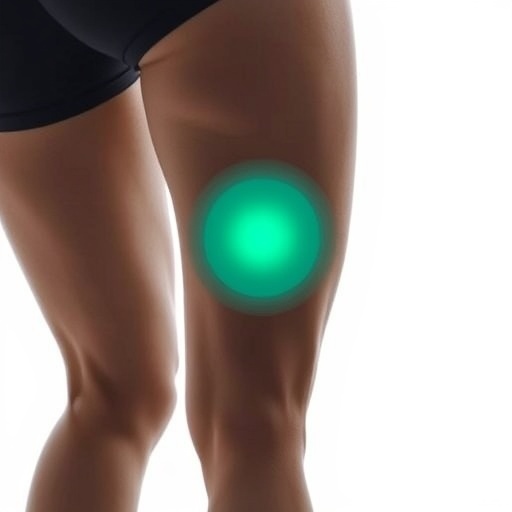In a groundbreaking study published in BMC Psychiatry, researchers have rigorously evaluated the precision of thigh-worn accelerometers in estimating sleep-wake patterns among adolescents, comparing their performance against polysomnography, the acknowledged gold standard of sleep measurement. This research marks a significant step toward more accessible and less invasive sleep monitoring, especially valuable for clinical populations of young people with mental disorders.
Sleep research traditionally relies on polysomnography, an extensive method involving multiple physiological recordings conducted overnight in a lab environment. While polysomnography delivers comprehensive and accurate data, it is both costly and intrusive, limiting its practicality for widespread or repeated monitoring, particularly in vulnerable populations. This study sought to determine if thigh-worn accelerometers could serve as a reliable, simpler alternative to polysomnography in adolescents aged 15 to 17, including those diagnosed with Axis I mental disorders.
The study encompassed 146 adolescent participants from the Danish High Risk and Resilience Study. Each underwent one night of standard polysomnography simultaneously with continuous monitoring via a thigh-worn accelerometer. The researchers focused on key sleep parameters: total sleep time, sleep efficiency, sleep onset latency, wake after sleep onset (WASO), and the number of awakenings. Utilizing ActiPASS software, they extracted these metrics from the accelerometer data and evaluated their congruence against polysomnographic findings.
Results revealed that the ActiPASS system generally underestimated total sleep time by nearly 52 minutes and sleep efficiency by approximately 1.4%, indicating a subtle yet noteworthy deviation from polysomnographic measurements. Moreover, the number of awakenings was underestimated by nearly 14 events, while sleep onset latency and WASO were significantly overestimated by 24 and 26 minutes respectively. These discrepancies highlight the challenges inherent in translating raw accelerometry data into precise sleep-wake metrics.
Despite these variances, reliability analyses offered encouraging insights. Intraclass correlation coefficients (ICCs), a statistical measure of consistency, demonstrated high agreement between methods for total sleep time (0.88), suggesting strong reliability. Moderate correlations emerged for sleep efficiency (0.55), sleep onset latency (0.69), and WASO (0.64), supporting cautious optimism about the accelerometer’s utility. The reliability for the number of awakenings was lower (0.39), denoting limited accuracy in detecting brief arousals.
Importantly, subgroup analyses identified slightly better correlations in adolescents without mental disorders compared to those with diagnosed Axis I conditions. This finding raises intriguing questions about the interaction between mental health status and the accuracy of wearable sleep assessment tools. Differences in sleep architecture or movement patterns in clinical populations may affect accelerometer readings and warrant further investigation.
Beyond correlation measures, the study also assessed the diagnostic performance of thigh-worn accelerometers using sensitivity and specificity analyses based on clinically relevant cut-offs. Remarkably, the system achieved perfect sensitivity and high specificity in detecting total sleep time less than six hours—a critical marker of insufficient sleep linked to numerous health problems. Sensitivity was also high, though specificity was moderate, for WASO greater than 50 minutes and sleep onset latency exceeding 30 minutes.
These findings underscore the significant potential of thigh-worn accelerometers as a non-invasive, cost-effective tool for initial sleep disturbance screening in adolescents, particularly within psychiatric settings where repeated polysomnography may be impractical. The capacity to monitor key sleep disturbances remotely could transform clinical practice and research, promoting timely interventions and personalized care strategies.
Technologically, thigh placement of accelerometers offers advantages over wrist-worn devices, which are more commonly studied. The thigh provides a more stable position that better captures rest-activity cycles and reduces signal noise from unrelated movements. However, the study also highlights the nuanced challenges in processing accelerometer data to delineate sleep states, suggesting ongoing refinement of algorithms like those used in ActiPASS remains necessary.
Furthermore, the broader implications of this work point towards integrating wearable technology into longitudinal mental health assessments. Sleep disturbances often precede or exacerbate psychiatric disorders; thus, reliable ambulatory sleep monitoring could facilitate early detection and tracking of symptom trajectories. This could enable healthcare providers to tailor treatments with greater precision and monitor responses in real time.
The successful validation of thigh-worn accelerometers in this complex adolescent cohort invites expansion to other age groups and clinical populations. Exploring their utility in younger children, adults with diverse comorbidities, or in community settings represents a promising avenue for future research, potentially bridging gaps between controlled laboratory studies and real-world sleep behaviors.
In summary, this study illuminates the promising role of thigh-worn accelerometry in democratizing access to sleep monitoring, especially for adolescents vulnerable due to mental health challenges. While some limitations in accuracy remain, the moderate to high reliability observed in essential sleep parameters lays a solid foundation for further development. Embracing wearable sleep technology could revolutionize both clinical diagnostics and epidemiological research by enabling scalable, ambulatory, and patient-friendly sleep assessments.
As the demand for personalized and accessible healthcare solutions intensifies, innovations like validated thigh-worn accelerometers herald a new era in sleep science. This study is a crucial contribution, demonstrating that sophisticated insights into sleep-wake patterns may soon be gleaned outside traditional laboratories, ultimately benefiting adolescent mental health outcomes worldwide.
Subject of Research: Validation of sleep-wake pattern estimation from thigh-worn accelerometers in adolescents with and without mental disorders.
Article Title: Validation of sleep-wake estimation from thigh-worn accelerometers against polysomnography in adolescents with and without mental disorders
Article References:
Wilms, M., Søndergaard, A., Jennum, P.J. et al. Validation of sleep-wake estimation from thigh-worn accelerometers against polysomnography in adolescents with and without mental disorders. BMC Psychiatry 25, 990 (2025). https://doi.org/10.1186/s12888-025-07304-2
Image Credits: AI Generated
DOI: https://doi.org/10.1186/s12888-025-07304-2




